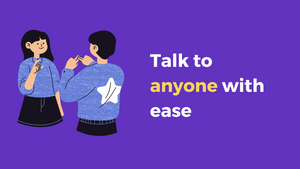
What makes a good communicator
Let's imagine we are in a meeting, in this meeting everybody is speaking and nobody is listing to the speaker. He has a great idea but it is lost in tension and misunderstandings.
Now, let's imagine another meeting, in this meeting speaker has everybody's attention, and everyone understands what she has to say.
You must be wondering, Why this difference? And that's what we are going to find out.
What made the difference?
It is effective communication. This skill is required for every aspect of life, whether it is professional life, personal relationship, or everyday conversation.
What makes a good communicator?
To answer this question we will explore from clarity in communication to empathy, and beyond in this article.
Table of Contents
The Clarity in Communication
It all starts with clarity in communication. This skill is the foundation for all the other communication skills.
The clarity in communication means your message is straightforward, and not confusing.
Definition of clarity in communication.
Clarity in communication means expressing your ideas, thoughts, and message in a way that your intended audience can easily understand.
It involves using simple language and avoiding jargon and other confusing words.
Clear communication also ensures that your intended message is received by your audience without any misunderstandings and misinterpretations.
Importance of using simple language and avoiding jargon
As I already mentioned, using jargon and less simple language is an important part of effective communication.
Using complex technical words or industry-specific words can create a barrier between you and your audience. Especially when your audience is not related to those fields.
Explaining your ideas, and thoughts using plain language with simple terms can your message available to a wider range of audience with a better understanding.
Tips for organizing thoughts and presenting ideas clearly
- Start with a clear objective: It is important to be clear about the purpose and objective of the message you are about to deliver. You can ask yourself some questions about your message. Like, what do you want to convey with your message? What are the key points of your message?
- Use a logical structure: Try to organize your message in a sequence, with a beginning, middle, and ending.
- Be concise: Use simple and clear language. Avoid unnecessary words and try to convey your ideas/thoughts without flooding them with unnecessary words and details. Here is an article about concise speaking - How to be more concise when speaking?
- Know your audience: Always try to consider the expectations, knowledge, and background of your audience when organizing your message. Use language and examples that are related to their field and knowledge and pivot your communication style accordingly.
- Use visuals: If possible, try to use some visuals, like diagrams, infographics, and charts that can make your message more clear and easier to understand.
- Seek feedback: It is a good practice to ask for feedback once you delivered your message. This can inform you that your message was understood as you intended. If not then be open and clarify with further explanations.
Active Listening
As I already mentioned in my other articles, a good communicator is also a good listener. It means you must not only hear the words but also engage in communication.
Definition of active listening
Active listening is, not only hearing the words but also understanding the speaker’s message. You must be present in the moment and actively engage in communication.
Why active listening is important in effective communication?
Active listening is important in effective communication to build trust, understand the message, and prevent misinterpretations.
It can build trust with the speaker because it can indicate that they are being heard and valued.
By actively listening you can understand the speaker’s message deeper without any misinterpretations and can ask for clarification.
If you want to learn more about effective listening including active listening then here is an article that I wrote on this topic - How to improve your listening skills?
Empathy in Communication
Empathy is not only an important part of effective communication but also what makes us human. It includes showing that you understand and acknowledge their emotions. Empathy creates a positive relationship and a sense of connection. It is an important part of personal relationships.
Ways to demonstrate empathy
- Acknowledge and validate emotions: Try to acknowledge the other person's emotions. You can use phrases like “I understand how you feel” or “Understandably, you are feeling …”.
- Use supportive language: Use words that show empathy. And always try to avoid judgemental language. You can use phrases like “I hear you”, “I appreciate your efforts”, or “That sounds challenging”.
- Share similar experiences: If you ever had a similar experience and if you can share it, then share it to show that you can relate to and understand their emotions. But don’t take the focus from their emotions.
- Offer support and assistance: Try to show a willingness to support them. If appropriate ask to offer help or assistance.
Non-Verbal Communication
Non-verbal communication is a type of communication that includes communicating without using words. It includes body language, facial expression, and tone of voice.
Non-verbal communication is important because it can convey more information than verbal communication. For example, to show friendliness which can show a warm smile. (Don’t overdo it)
Tips for effectively using non-verbal communication
- Be mindful of body language: Try to pay attention to your body posture, gestures, and hand movements. When communicating, avoid crossing your arms or looking away, because it conveys the meaning of disinterestedness or defensiveness.
- Be aware of facial expressions: Your facial expressions mostly convey your emotions. So ensure they are aligned with your message. For example, for a positive message, a genuine smile can create a positive environment.
- Pay attention to the tone of voice: Just like facial expressions, your tone of voice also conveys your emotions and attitudes. Adjust your tone according to your message.
- Use eye contact effectively: Eye contact is an important part of non-verbal communication. It conveys attentiveness, and trust. Try to maintain appropriate eye contact with your audience. But be careful, too much or too little eye contact can impact your communication and reputation.
Confidence in Communication
The ability to express yourself clearly, assertively, and with conviction is your confidence in communication. You can also think of it as faith in your communication skills.
Confidence can help you to express your thoughts, and ideas with effectiveness. It is also required to build trust with your audience. In addition, it is also important to balance it with humility and the ability to admit your mistakes whenever necessary.
Conclusion
In conclusion, effective communication is an important skill required in every aspect of our lives. And this is what makes a good communicator.
By using simple and jargon-free language with active listening in our message, we can make it more clear and more concise.
However, we should not forget to empathize with others. It involves showing understanding towards others. It is also what makes us human.
Non-verbal communication is also an important part of effective communication. We should always pay attention to our body language.
If you lack confidence, then all the above-mentioned skills will have little or no impact at all. It is important to communicate with enough confidence.
As we progress to become a better communicators, it is also important to continuously develop and hone these skills.
Remember, communication is not just about what you want to say, but also how you say it and how you listen to others.




